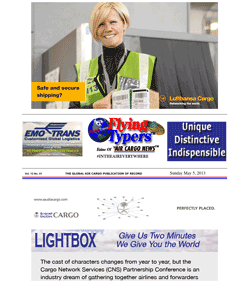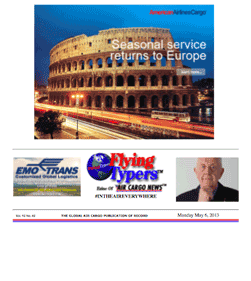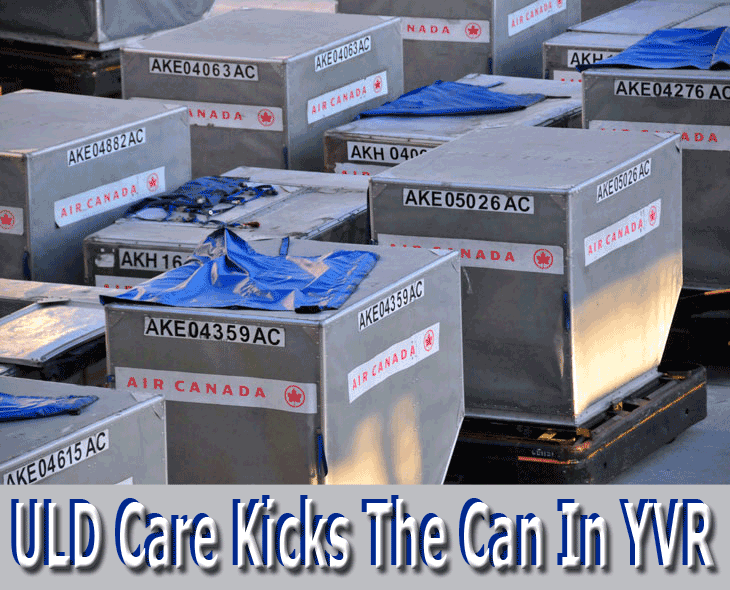
(Vancouver
Exclusive)—The
2013 Annual ULD CARE Conference
was last week in beautiful downtown
Vancouver, adjacent to the venue
hosting the annual IATA Ground
Handling Council meeting.
With
74 participants from airlines
and other ULD-related organizations,
conferees learned that tremendous
progress has been made in the
8 months since the September
2012 meeting in Shanghai.
Here
today is the launch of the ULD
CARE website (www.ULDCARE.com),
plus the first edition of the
ULD CARE e-newsletter and the
launch of various groups tasked
with ULD initiatives. South
African Airlines, Tampa Cargo,
and TAP Portugal joined the
group for the first time.

Building
on the 2012 decision to work
closely with all components
of the cargo supply chain, ULD
CARE has taken the initiative
to collaborate with the IGHC
conference with a stand in their
exhibition and a presentation
on the opening morning, leading—it’s
hoped—to closer integration
of ULD CARE and the ground handling
community.
High
on the agenda was an in-depth
discussion on how the standard
IATA 10-digit ULD identification
code system (e.g. AKE12345AC)
in use on maybe 700,000 ULDs
worldwide might be adapted to
cope with the proliferation
of different configurations
and new sub-groups of ULD that
are found in the industry today
and can be expected in future.
The
current format doesn’t
lend itself to reflect present
requirements such as lightweight
units, fire suppression equipment,
or temperature controlled ULDs.
It goes without saying that
any changes would trigger IT
system modifications everyone
wants to avoid.
The
IATA CBPP has recognized the
need to add a heretofore missing
format for ULD Rate Class Type
in the next edition of Cargo-IMP.
Another option is making a change
to the ULD Regulations by allowing
the use of position 4 as a code
to designate a new category.

Another
key accomplishment of ULD CARE
has been to carry out a major
redesign of the current ULD
Control Receipt, which on one
hand is widely used to control
the handoff of ULD between parties
but on the other hand is still
based on ‘60 SITA message
format.
The
new user-friendly format will
be presented to the IATA ULD
Technical Panel for consideration
as a replacement for the old
format, opening the door for
electronic messaging of ULD
transfers between two or more
parties.

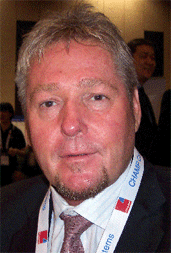 Citing
heavy responsibilities at his
carrier, UPS, Dick O’Mara
announced that he’s stepping
down as president of ULD CARE;
former vice president Urs Wiesendanger
(left) was elected president. Citing
heavy responsibilities at his
carrier, UPS, Dick O’Mara
announced that he’s stepping
down as president of ULD CARE;
former vice president Urs Wiesendanger
(left) was elected president.
Going
through the list of forward-looking
goals, Urs mentioned adding
ten more airlines to the membership,
as well as five more non-airline
members.
Continued
development of the current system
and smart phone apps will add
value and facilitate tracking
ULD transfers.
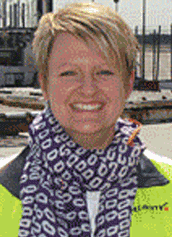 Jettainer’s
Irene Gräf, (right)Head
of ULD Control Desk Europe/Asia,
presented “Trends in ULD
Management – supporting
ULD Care and industry goals”
focusing on main challenges
including localization, availability,
and damage prevention. Irene
said, “With 89 percent
of ULDs being handled by ground
handlers and an average 50-60
percent of the total cost of
ownership ascribed to ULD damage,
development of not only lightweight
but damage resistant materials
is critical.” Jettainer’s
Irene Gräf, (right)Head
of ULD Control Desk Europe/Asia,
presented “Trends in ULD
Management – supporting
ULD Care and industry goals”
focusing on main challenges
including localization, availability,
and damage prevention. Irene
said, “With 89 percent
of ULDs being handled by ground
handlers and an average 50-60
percent of the total cost of
ownership ascribed to ULD damage,
development of not only lightweight
but damage resistant materials
is critical.”
With
professional dedicated ULD management
services coming of age, making
better use of data and digitization
stands to deliver on the promise
of dynamic ULD networks.
 Workmanlike
detail continued with an ISO
TC20 SC9 (the air cargo sub-committee
of ISO TC20, Aerospace) liaison
report that constitutes the
technical reference for Civil
Aviation regulations (TSO) and
a number of standards and revisions
dealing with straps and containers. Workmanlike
detail continued with an ISO
TC20 SC9 (the air cargo sub-committee
of ISO TC20, Aerospace) liaison
report that constitutes the
technical reference for Civil
Aviation regulations (TSO) and
a number of standards and revisions
dealing with straps and containers.
Perennial
topics such as a single method
to test pallet nets, and environmental
and degradation testing continue
to be on the agenda.
Furthermore,
consideration will be given
to more precisely defining non-certified
ULD strength requirements, which
was brought up at WCS.
Bob
Rogers (left) of Nordisk gave
the regulatory update and highlighted
the foreseen impact on the industry,
with authorities moving rapidly
towards life limits on any non-metallic
items.
Bob
concluded by saying that “a
TSO is not an operating instruction
to use that item; it is an endorsement
by an aviation authority that
the TSO-approved item meets
a certain minimum performance
standard.”

M2M
(machine-to-machine communications)
has taken the world by storm
and the potential for using
this proven technology in ULDs
is both tantalizing and self-evident.
Telemetry-equipped
units can be visualized and
locations shown on a map or
satellite image.
It’s
also possible to create geo-fences
around some areas so that when
a ULD isn’t supposed to
be moved outside a warehouse,
a fence is drawn around the
warehouse on the map, and an
e-mail is sent if it’s
moved outside that geo-fence.
ULDs
with integrated telemetry are
the key to improving the active
cold chain by reducing risks
and increasing availability.
End-users
will have immediate access to
quality data and peace of mind
regarding product condition
throughout transit. Partners
within the active cold chain
network will also have real-time
condition alerts on units to
facilitate proactive response
procedures, maintenance awareness,
and improved return procedures.
What
are we waiting for?
In his presentation to the IGHC
meeting next door, newly elected
president ULD CARE Urs Wiesendanger
elaborated on the functions
and benefits of the ULD demurrage
system database and then took
on the main issue between airlines
and ground handlers when it
comes to ULDs. In his words,
“airlines are responsible
and accountable to aviation
authorities to use only airworthy
ULD on all flights and for the
costs associated with maintaining
ULD in airworthy condition.
While ground handlers are responsible
to airlines for providing ground
handling facilities for ULD,
handlers have only limited responsibility
for the care of ULDs, and also
equally limited financial exposure.”
Ted
Braun
|




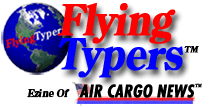

 Citing
heavy responsibilities at his
carrier, UPS, Dick O’Mara
announced that he’s stepping
down as president of ULD CARE;
former vice president Urs Wiesendanger
(left) was elected president.
Citing
heavy responsibilities at his
carrier, UPS, Dick O’Mara
announced that he’s stepping
down as president of ULD CARE;
former vice president Urs Wiesendanger
(left) was elected president.
 Jettainer’s
Irene Gräf, (right)Head
of ULD Control Desk Europe/Asia,
presented “Trends in ULD
Management – supporting
ULD Care and industry goals”
focusing on main challenges
including localization, availability,
and damage prevention. Irene
said, “With 89 percent
of ULDs being handled by ground
handlers and an average 50-60
percent of the total cost of
ownership ascribed to ULD damage,
development of not only lightweight
but damage resistant materials
is critical.”
Jettainer’s
Irene Gräf, (right)Head
of ULD Control Desk Europe/Asia,
presented “Trends in ULD
Management – supporting
ULD Care and industry goals”
focusing on main challenges
including localization, availability,
and damage prevention. Irene
said, “With 89 percent
of ULDs being handled by ground
handlers and an average 50-60
percent of the total cost of
ownership ascribed to ULD damage,
development of not only lightweight
but damage resistant materials
is critical.” Workmanlike
detail continued with an ISO
TC20 SC9 (the air cargo sub-committee
of ISO TC20, Aerospace) liaison
report that constitutes the
technical reference for Civil
Aviation regulations (TSO) and
a number of standards and revisions
dealing with straps and containers.
Workmanlike
detail continued with an ISO
TC20 SC9 (the air cargo sub-committee
of ISO TC20, Aerospace) liaison
report that constitutes the
technical reference for Civil
Aviation regulations (TSO) and
a number of standards and revisions
dealing with straps and containers.
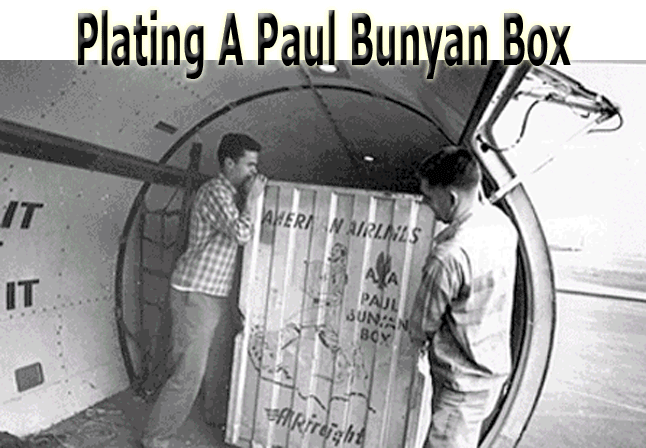
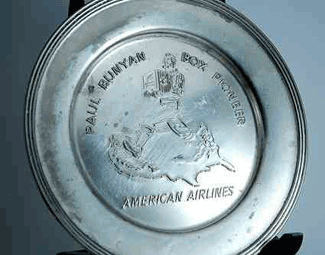 AA
Cargo can count many industry
firsts: launching the first
scheduled air cargo service
in the world; the first air
cargo tariff to establish
service based on density,
volume, value, and perishability;
and (our favorite) the first
Unit Load Device (ULD), known
as the Paul Bunyan Box.
AA
Cargo can count many industry
firsts: launching the first
scheduled air cargo service
in the world; the first air
cargo tariff to establish
service based on density,
volume, value, and perishability;
and (our favorite) the first
Unit Load Device (ULD), known
as the Paul Bunyan Box.
 On
April 29, 2013, in line with
the new European Union security
regulations, AF-KL-MP Cargo
opened a new, innovative security
screening method at the Schiphol
hub. Dutch authorities approved
the so-called Remote Explosive
Scent Tracing (REST) method
at truck level at the end of
last year. It allows for screening
an entire truckload of cargo
at once by specially trained
explosive detection dogs.
On
April 29, 2013, in line with
the new European Union security
regulations, AF-KL-MP Cargo
opened a new, innovative security
screening method at the Schiphol
hub. Dutch authorities approved
the so-called Remote Explosive
Scent Tracing (REST) method
at truck level at the end of
last year. It allows for screening
an entire truckload of cargo
at once by specially trained
explosive detection dogs. 
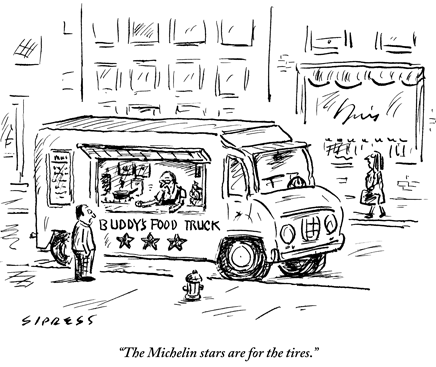 You
can imagine our surprise when
we discovered the big VIP dinner
at the CNS Partnership Conference
was served up alfresco via a
half-dozen food trucks. Perhaps
it was perfectly fitting; they
were indeed reminiscent of the
trucks seen at cargo areas around
JFK and MIA.
You
can imagine our surprise when
we discovered the big VIP dinner
at the CNS Partnership Conference
was served up alfresco via a
half-dozen food trucks. Perhaps
it was perfectly fitting; they
were indeed reminiscent of the
trucks seen at cargo areas around
JFK and MIA.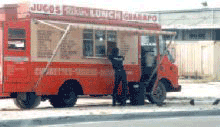 Still
we can’t help but remember
the genuine food trucks that
we grew to love at JFK, like
the legendary, always dripping
Tobo Foods Rolling Cafeteria
from the 1980s, or the Rikin
Café On Wheels in Miami.
Still
we can’t help but remember
the genuine food trucks that
we grew to love at JFK, like
the legendary, always dripping
Tobo Foods Rolling Cafeteria
from the 1980s, or the Rikin
Café On Wheels in Miami.